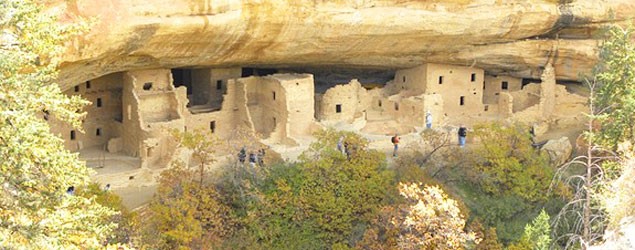
Mummy Lake is a sandstone-lined circular pit that was originally 90 feet (27.5 meters) across and 22 feet (6.65 m) deep. In 1917, American naturalist Jesse Walter Fewkes pegged the structure as a prehistoric water reservoir. Several subsequent studies of Mummy Lake have also supported this view, leading the National Parks Service to officially name the structure "Far View Reservoir" in 2006. (Far View refers to the group of archaeological structures located on the northern part of the park's Chapin Mesa ridge, where Mummy Lake is also situated.)
In the new study, researchers analyzed the hydrologic, topographic, climatic and sedimentary features of Mummy Lake and the surrounding cliff area. They concluded that, contrary to what previous research had determined, the pit wouldn't have effectively collected or distributed water.
"The
fundamental problem with Mummy Lake is that it's on a ridge," said
study lead author Larry Benson, an emeritus research scientist for the
U.S. Geological Survey and adjunct curator of anthropology at the
University of Colorado Museum of Natural History. "It's hard to believe
that Native Americans who understood the landscape and were in need of water would have decided to build a reservoir on that ridge."
A supposed reservoir
Far
View Village lies on a ridgeline that decreases in elevation from north
to south, and includes Far View House, Pipe Shrine House, Far View
Tower, Mummy Lake and other buildings. Previously, scientists had
thought Mummy Lake — the northernmost structure — was a key part of a
large water collection and distribution system that transported water
between these structures to areas south of the reservoir.A panorama of Mummy Lake in Colorado's Mesa Verde National Park.
They proposed that a
gathering basin was once located uphill from Mummy Lake, and that a
hypothetical "feeder ditch" connected the two locations. Studies have
shown that another shallow, foot-paved ditch runs south from Mummy Lake
to Far View House and Pipe Shrine House, and a third ditch connects Far
View Village to Spruce Tree House and Cliff Palace (two structures built
centuries after the Far View group) farther south.
The
prevailing idea was that precipitation would first collect in the
basin, and then travel down to Mummy Lake along the ditch; from there,
some of it could then travel to the rest of the village, providing water
for drinking and irrigating crops.
"I
think it's appealing to think of Mummy Lake as a reservoir," Benson
told Live Science, noting that the Ancestral Puebloans of Mesa Verde
lived in a region without any natural bodies of water. "[Scientists]
naturally want to find structures that hold or convey water, to explain
how the people got their water."
Testing the theory
To
test this reservoir theory, Benson and his colleagues first analyzed
the topography and hydrology of the ridge using GPS surveys,
high-resolution imagery and digital elevation models.
They
found that the ditches leading from Mummy Lake to the southern
structures couldn't have functioned as water canals or irrigation
distribution systems. The ditches would have easily spilled water over
the canyon edge at various points if it didn't have walls controlling
the water flow (which don't appear to have existed).
Far View Village lies on a ridgeline that decreases in elevation from north to south
Next, the team used climate models
to investigate Mummy Lake's potential to store water. They found that
even in the wettest year on record, 1941, the pit would have gotten less
than a foot of water from winter and spring precipitation by the end of
April. This water would have completely evaporated by the end of July,
when it's most needed for crops.
The
researchers then tested if a hypothetical feeder ditch could actually
provide Mummy Lake with water. "The engineering and sediment transport
work showed that any water in the ditch would start moving so much dirt
that it would block the path," Benson said. That is, soil would have
quickly clogged the ditch after regular rainfall, preventing the water
from reaching Mummy Lake.
A ceremonial structure?
Benson and his colleagues propose Mummy Lake is an unroofed ceremonial structure, not unlike the ancient kivas and plazas elsewhere in the Southwest. They noted that the structure is similar in size to a great kiva found at a Pueblo historical
site near Zuni, N.M. It also resembles a ball court and amphitheater at
the Puebloan village of Wupatki in Arizona — interestingly, Fewkes also
thought these two structures were reservoirs.
Furthermore,
the ditches connecting Mummy Lake to Far View Village, Spruce Tree
House and Cliff Palace aren't canals to transport water, but rather
Chacoan ceremony roads with similar dimensions to Chacoan roads that
exist at other sites in the San Juan Basin, the researchers argue.
Two
decades ago, researchers studying the Manuelito Canyon Community of New
Mexico discovered the Ancestral Puebloan population had an evolving
ritual landscape. Over the centuries, the Manuelito people relocated the
ritual focus of their community several times. Each time they moved,
they built ceremonial roads to connect their retired great houses and
great kivas to the new complexes.
Benson
and his colleagues suspect the same thing happened at Mesa Verde. Mummy
Lake was built as early as A.D. 900, around the same time as the rest
of the Far View group of structures; Cliff Palace and Spruce Tree House,
on the other hand, date to the early 1200s. The researchers think the
community relocated to the latter structures between A.D. 1225 and 1250,
and connected their past with their present using the ceremonial roads.
If
the Far View Reservoir really had nothing to do with water, then it may
be time for another name change. "I think [the structure] needs new
signage," Benson said. "We could probably call it 'Mummy Lake' again."
The study was detailed in the April issue of the Journal of Archaeological Science.

No comments:
Post a Comment